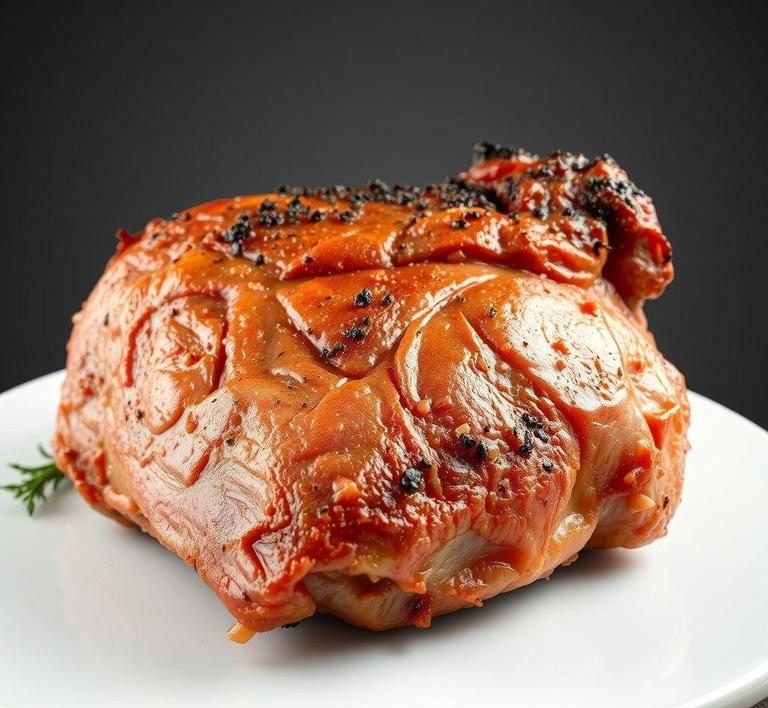If you’ve ever found yourself with leftover pork shoulder and wondered whether it’s safe to refreeze, you’re not alone! Refreezing pork shoulder is totally doable, but there are a few important steps and guidelines to follow to ensure it stays delicious and safe to eat. Whether you’ve cooked up a big batch and have leftovers or bought more than you can use in one go, understanding the right way to store and refreeze your pork shoulder is key to preserving its texture, flavor, and safety. In this guide, we’ll walk you through everything you need to know about properly refreezing pork shoulder, from thawing to reheating, so you can enjoy it without any worries!
Can You Refreeze Pork Shoulder?

Refreezing pork shoulder-or any type of meat-can be a bit of a culinary conundrum. On one hand, the desire to reduce food waste is commendable, and on the other hand, there are important safety concerns that must be considered when handling meat. The question of whether you can refreeze pork shoulder is not a simple "yes" or "no" but rather depends on a few critical factors.
At the core of the issue is the handling of the pork shoulder after it has been thawed. Refreezing meat is only safe if it has been thawed correctly and hasn’t been left in the danger zone for too long. The danger zone refers to temperatures between 40°F and 140°F (4°C to 60°C), where bacteria can multiply rapidly. If the pork shoulder has been kept at a consistent, safe temperature-either in the refrigerator or constantly frozen-it is generally safe to refreeze.
However, once the meat has thawed at room temperature or been in the danger zone for extended periods, bacteria can grow to unsafe levels, making the refreezing process potentially dangerous. It’s also worth noting that while it’s safe to refreeze pork shoulder in certain circumstances, doing so could affect the quality and texture of the meat.
How To Refreeze Pork Shoulder?
If you find yourself needing to refreeze pork shoulder, following a few steps can help minimize any risks and maintain as much quality as possible. Here’s how to do it right:
1. Thawing Properly
The first step to safely refreeze pork shoulder is to ensure it was thawed in the safest possible way. The best method is to thaw it slowly in the refrigerator, where the temperature remains consistently low, reducing the risk of bacterial growth. If you thaw the pork shoulder in the microwave or in warm water, these methods should only be used if you plan on cooking it immediately after thawing. Once thawed, cooking the meat before refreezing is the safest option.
2. Cook Before Refreezing
If you’ve thawed the pork shoulder and know you won’t be able to use it immediately, cooking it before refreezing is the best option. Cooking pork shoulder destroys bacteria that might have begun to grow during the thawing process, thereby ensuring it is safe for refreezing. After cooking, ensure the meat cools down to room temperature before placing it in the freezer to avoid condensation, which can cause freezer burn.
3. Packaging For Refreezing
Once you have your cooked or raw pork shoulder ready to refreeze, it’s important to package it well. Use freezer-safe bags or airtight containers to minimize exposure to air. Vacuum-sealing is an excellent option for long-term storage as it removes most of the air that causes freezer burn and degradation in quality.
If you’re refreezing raw pork shoulder, ensure it is well-wrapped in plastic wrap, followed by a layer of aluminum foil or placed inside a freezer bag. If the pork has been cooked, allow it to cool completely before wrapping or packaging it in the same way.
4. Labeling And Freezing
To avoid confusion in the future, label your packages with the date they were frozen. This is especially important when refreezing, as you want to make sure you use it within a reasonable timeframe, typically within three to four months, to ensure the best quality.
5. Consideration Of Meat Cuts
If you’re working with a whole pork shoulder, cutting it into smaller portions can help maintain quality when refreezing. Smaller pieces freeze more evenly, and you can defrost only what you need, reducing waste.
Quality Impact
While it’s safe to refreeze pork shoulder under the right conditions, there will inevitably be some impact on quality. Freezing and thawing meat can cause changes in texture and moisture content, which will affect how the meat feels and tastes once it’s cooked. Here’s a closer look at the quality impact:
Texture
The main downside to refreezing pork shoulder is the potential loss of texture. When meat freezes, ice crystals form inside the muscle fibers. These ice crystals can puncture the fibers, causing them to break down. When the meat is thawed and refrozen, this damage can be compounded, leading to a mushier, less satisfying texture. In particular, cuts like pork shoulder that are naturally tougher may become even more fibrous or rubbery.
Moisture Loss
Freezing and thawing meat causes it to lose moisture. Each time the meat is frozen and thawed, more of the natural juices are lost, which can lead to dryness. When pork shoulder is refrozen, it may lose even more of its juiciness. While this can be minimized by cooking the meat before refreezing and storing it properly, the effect on moisture content will still be noticeable.
Flavor
The impact on flavor tends to be less noticeable than on texture, but repeated freezing can lead to slight changes in taste. Freezer burn-caused by the formation of ice crystals on the surface of the meat due to air exposure-can result in a somewhat off flavor, especially if the pork shoulder was not sealed properly. However, if you cook the meat after refreezing, the changes in flavor are usually minor and can often be masked by seasoning or cooking methods.
Nutritional Value
Freezing and refreezing don’t have a significant effect on the nutritional value of pork shoulder, but if it’s improperly thawed or refrozen several times, there could be a slight loss in vitamins or minerals. That said, these changes are usually negligible compared to the potential impact on taste and texture.
While it is safe to refreeze pork shoulder under certain conditions, it’s crucial to follow proper procedures to avoid potential health risks and maintain as much quality as possible. The key is to ensure that the pork has been thawed correctly-either in the refrigerator or cooked immediately after thawing-before it’s refrozen.
Although there is no inherent danger in refreezing pork shoulder if done properly, the quality of the meat will suffer somewhat in terms of texture, moisture retention, and potentially flavor. To minimize these issues, consider cooking the pork shoulder before refreezing, and always package it well to prevent freezer burn.
Ultimately, refreezing pork shoulder is a viable option, but only if you’re aware of the potential quality loss. If you’re okay with a slight dip in texture and moisture, then refreezing can help extend the shelf life of your pork shoulder. However, if you’re looking for the best possible eating experience, it’s always best to cook and consume the meat within a reasonable time frame after the initial thaw.
Is It Safe To Refreeze Pork Shoulder?
When it comes to the question of refreezing pork shoulder, the short answer is: it can be done, but with a lot of careful consideration. Refreezing meat, in general, raises concerns about food safety, quality, and texture.
Pork shoulder, a rich and fatty cut of meat, is particularly susceptible to changes in texture and flavor when frozen and thawed repeatedly. The USDA states that meat can technically be refrozen if it has been thawed in the refrigerator and hasn’t reached temperatures above 40°F (4°C) for more than two hours. However, while it’s technically safe to refreeze pork shoulder after proper thawing, you should be mindful of the cumulative impact on the meat’s quality.
When you freeze meat, ice crystals form within the cells. Upon thawing, these crystals can rupture cell walls, leading to a loss of moisture. The more times this process is repeated, the drier, tougher, and less flavorful the pork shoulder becomes. Furthermore, there’s the risk of bacterial growth if meat is improperly handled during the thawing or refreezing process, which can lead to foodborne illnesses.
So, yes, it is safe to refreeze pork shoulder under the right conditions, but only once. If you’re planning on refreezing, ensure the pork shoulder has been stored at a safe temperature during both thawing and refreezing, and be prepared for a slightly altered texture once cooked.
Signs That Pork Shoulder Should Not Be Refrozen
There are several indicators to look for when deciding whether pork shoulder is safe to refreeze or not. The key is assessing its condition in terms of temperature history, appearance, and smell.
- Improper Thawing Conditions: If the pork shoulder has been thawed at room temperature for more than two hours or has been left out in a warm environment (above 40°F or 4°C), it should not be refrozen. Bacteria grow rapidly at these temperatures, increasing the risk of foodborne illnesses.
- Off or Sour Smell: Fresh pork should have a clean, slightly metallic or neutral scent. If the pork shoulder has a sour or rancid smell, it is no longer safe to consume, and refreezing it will not make it safe. An off smell often indicates that the meat has started to spoil, and refreezing would not improve its condition.
- Discoloration: If the pork shoulder has changed color from its usual pinkish hue to a grayish or brownish tone, it may be a sign that it’s starting to degrade. While slight discoloration might occur naturally during freezing and thawing, significant changes in color are a red flag that the pork has been improperly stored and is no longer good to eat.
- Excessive Ice Crystals or Freezer Burn: Large ice crystals forming on the surface of the pork shoulder or signs of freezer burn (such as discolored, dried-out patches) indicate that the meat has been frozen for an extended period and may have already lost much of its moisture. Refreezing meat with freezer burn won’t make it unsafe, but the texture and flavor will be significantly compromised.
- Soft, Slimy Texture: If the pork shoulder feels slimy or excessively soft, it has probably begun to spoil. Freezing and refreezing will not make spoiled meat safe to eat, and the texture will continue to degrade.
Common Refreezing Mistakes
Refreezing pork shoulder might seem simple, but there are several common mistakes that people make that can compromise both the safety and quality of the meat. Understanding these pitfalls is key to keeping your pork shoulder in good shape.
- Thawing on the Counter: One of the most common mistakes is leaving pork shoulder out at room temperature to thaw. While this may speed up the process, it also encourages bacteria to multiply. Always thaw pork shoulder in the refrigerator, not on the counter, and never leave it in warm environments for extended periods. A quick thawing process might seem convenient, but it’s not worth the risk of foodborne illness.
- Refreezing Multiple Times: Refreezing pork shoulder multiple times is a huge mistake. As mentioned earlier, each freeze-thaw cycle deteriorates the meat’s quality. Refreezing multiple times can make the meat dry, tough, and flavorless. Ideally, you should only refreeze pork once after it has been properly thawed in the fridge.
- Not Wrapping the Meat Properly: Another mistake is failing to wrap the pork shoulder properly before freezing it. If meat is not sealed in an airtight container or wrapped tightly in plastic wrap and foil, it can develop freezer burn. Freezer burn doesn’t make the meat unsafe to eat, but it results in dry, unappetizing pieces of pork. Always ensure the pork is well-sealed to maintain its quality.
- Thawing Too Quickly: Thawing pork shoulder too quickly, such as by using warm water or a microwave, can cause the meat to lose moisture and texture. The safest method is slow thawing in the fridge, which ensures the pork remains at a safe temperature throughout the process. Quick thawing methods are especially risky when you plan to refreeze the meat.
- Overloading the Freezer: If you’re refreezing large amounts of pork shoulder or other meats at once, overloading the freezer can lead to uneven cooling. This means that some parts of the pork might not freeze as quickly as others, which can cause the meat to be in the ‘danger zone’ (40°F to 140°F) for too long, promoting bacterial growth.
Tips And Tricks
Now that we’ve covered the safety aspects, let’s dive into some practical tips and tricks to help you preserve the quality of your pork shoulder during freezing, thawing, and refreezing.
- Use Vacuum Sealing: If you’re freezing pork shoulder for longer storage, consider vacuum-sealing the meat. This method removes air and creates a tight seal around the meat, reducing the risk of freezer burn and preserving its flavor and texture. Vacuum-sealing can also extend the shelf life of pork shoulder.
- Portion Control: Instead of freezing the entire pork shoulder in one go, try portioning it into smaller pieces. This way, you can thaw only the amount you plan to cook, avoiding the need to refreeze unused portions. Smaller portions also thaw more quickly and evenly.
- Label and Date: Always label your frozen pork with the date it was frozen and the ‘use by’ date. Pork shoulder can last about 4-6 months in the freezer, but it’s best to consume it sooner to maintain optimal quality.
- Thaw Slowly: Always plan ahead and allow your pork shoulder to thaw slowly in the refrigerator. Depending on the size, this could take anywhere from 24 to 48 hours. Thawing in the fridge keeps the pork at a safe temperature, preventing bacteria from growing.
- Cook Before Refreezing: If you’ve cooked the pork shoulder and have leftovers, it’s a good idea to freeze those cooked portions. Cooked pork freezes and thaws much better than raw pork. Additionally, reheating cooked pork will help retain moisture and flavor, unlike refreezing raw meat, which often loses more of its natural juices.
Conclusion
While it is possible to refreeze pork shoulder, it’s not always ideal. The key is to ensure that the meat is thawed properly and stored at safe temperatures to avoid bacterial growth. However, the more times you freeze and thaw pork shoulder, the more it loses in terms of quality, texture, and flavor. Proper wrapping, portioning, and using techniques like vacuum sealing can help preserve the meat’s integrity for longer periods.
If you notice signs of spoilage or if the pork has been thawed improperly, it’s better to discard it rather than take the risk. By following these safety measures and tips, you can refreeze pork shoulder successfully, but always prioritize maintaining the best quality possible to ensure a safe and enjoyable meal.


